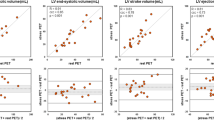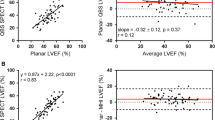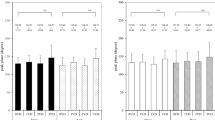Abstract
To evaluate left ventricular (LV) wall motion stereoscopically from all directions and to calculate the LV volume by three-dimensional (3D) imaging,99mTc-DTPA human serum albumin-multigated cardiac pool-single photon emission computed tomography (99mTc-MUGA-SPECT) was performed. A new data processing program was developed with the Application Visualization System-Medical Viewer (AVS-MV) based on images obtained from99mTc-MUGA-SPECT. In patients with previous myocardial infarction, LV function and LV wall motion were evaluated by 3D-99mTc-MUGA imaging. The LV end-diastolic volume (LVEDV) and end-systolic volume (LVESV) were obtained from 3D-99mTc-MUGA images by the surface rendering method, and the left ventricular ejection fraction (LVEF) was calculated at thresholds of 35% (T1), 40% (T2), 45% (T3), and 50% (T4). There was a strong correlation between the LV volume calculated by 3D-99mTc-MUGA imaging at a threshold of 40% and that determined by contrast left ventriculography (LVEDV: 194.7 ± 36.0ml vs. 198.7 ± 39.1ml, r = 0.791, p < 0.001; LVESV: 91.6 ± 44.5ml vs. 93.3 ± 41.3ml, r = 0.953, p < 0.001), respectively. When compared with the LVEF data obtained by left ventriculography, significant correlations were found for 3D images reconstructed at each threshold (T1: r = 0.966; T2: r = 0.962; T3: r = 0.958; and T4: r = 0.955). In addition, when LV wall motion obtained by 3D-99mTc-MUGA imaging (LAT and LAO views) was compared with the results obtained by left ventriculography (RAO and LAO views), there was good agreement.
3D-99mTc-MUGA imaging was superior in allowing evaluation of LV wall motion in all directions and in assessment of LV function, since data acquisition and image reconstruction could be done within a short time with the three-detector imaging system and AVS-MV. This method appears to be very useful for the observation of both LV wall motion and LV function in patients with ischemic heart disease, because it is a noninvasive examination.
Similar content being viewed by others
References
Burow RD, Strauss HW, Singleton R, Pond M, Rehn T, Bailey IK. Analysis of the ventricular function from multiple gated acquisition cardiac blood pool imaging: Comparison to contrast angiography.Circulation 56: 1024–1028, 1977.
Rieber JHC, Lie WH, Kooij PPM. Clinical validation of fully automated computation of ejection fraction from gated equilibrium blood-pool scintigrams.J Nucl Med 24: 1099–1107, 1983.
Ekman M, Lomsky M, Stromblad SO, Carlsson S. Closedline integral optimization edge detection algorithm and its application in equilibrium radionuclide angiocardiography.J Nucl Med 36: 1014–1018, 1995.
Vera P, Gardin I, Bok B. Comparative study of three automatic programs of left ventricular ejection fraction evaluation.Nucl Med Commun 16: 667–674, 1995.
Corbett JR, Janson DE, Lewis SE, Gabliani GI, Nicod P, Filipchuck NG, et al. Tomographic gated blood pool radionuclide ventriculography: analysis of wall motion and left ventricular volumes in patients with coronary artery disease.J Am Coll Cardiol 6: 349–358, 1985.
Gill JB, Moore RH, Tamaki N, Miller D, Barkai-Kovach M, Yasuda T, et al. Multi-gated blood-pool tomography: new method for the assessment of left ventricular function.J Nucl Med 12: 1916–1924, 1986.
McGhie AI, Faber TL, Willerson JT, Corbett JR. Evaluation of left ventricular aneurysm after acute myocardial infarction using tomographic radionuclide ventriculography.Am J Cardiol 75: 720–724, 1995.
Handschumacher MD, Lethor JP, Siu SC, Mele D, Rivera JM, Picard MH, et al. A new integrated system for threedimensional echocardiographic reconstruction: development and validation for ventricular volume with application in human subjects.J Am Coll Cardiol 21: 743–753, 1993.
Sapin PM, Schroeder KM, Smith MD, De Maria AN, King DL. Three-dimensional echocardiographic measurement of left ventricular volumein vitro: comparison to twodimensional echocardiography and cineventriculography.J Am Coll Cardiol 22: 1530–1537, 1993.
Gopal AS, Shen Z, Sapin PM, Keller AM, Schnellbaecher MJ, Leibowitz DW, et al. Assessment of cardiac function by three-dimensional echocardiography compared with conventional noninvasive methods.Circulation 92: 842–853, 1995.
Siegel CS. Creating 3D models from medical images using AVS. 1995 international advanced visual systems users group conference proceedings, Boston, Massachusetts April 19–21; pp. 424–431, 1995.
Sandler H, Dodge HT. The use of single plane angiocardiograms for the calculation of left ventricular volume in man.Am Heart J 75: 325–334, 1968.
Sheehan FH, Bolson EL, Dodge HT, Mathey DG, Schofer J, Woo HW. Advantages and application of the centerline method for characterization regional ventricular function.Circulation 74: 293–305, 1986.
Dymond DS, Elliott A, Stone D, Hendirix G, Spurrell R. Factors that affect the reproducibility of measurements of left ventricular function from first-pass radionuclide ventriculograms.Circulation 65: 311–322, 1982.
Hecht HS, Josephson MA, Hopkins JM, Singh BN, Parzen E, Elashoff J. Reproducibility of equilibrium radionuclide ventriculography in patients with coronary artery disease: Response of left ventricular ejection fraction and regional wall motion to supine bicycle exercise.Am Heart J 104: 567–574, 1982.
Kelbaek H, Gjorup T, Bulow K, Nielsen SL. Observer variability of radionuclide left ventricular volume determination at rest and during exercise.Acta Radiol 34: 179–182, 1993.
White HD, Norris RM, Brown MA, Brandt PW, Whitlock RML, Wild CJ. Left ventricular end-systolic volume as the major determinant of survival after recovery from myocardial infarction.Circulation 76: 44–51, 1987.
Faber TL, Stokely EM, Templeton GH, Akers MS, Parkey RW, Corbett JR. Quantification of three-dimensional left ventricular segment wall motion and volumes from gated tomographic radionuclide ventriculograms.J Nucl Med 30: 638–649, 1989.
Faber TL, Akers MS, Peshock RM, Corbett JR. Three dimensional motion and perfusion quantification in gated single-photon emission computed tomograms.J Nucl Med 32: 2311–2317, 1991.
Author information
Authors and Affiliations
Rights and permissions
About this article
Cite this article
Yamazaki, J., Naitou, K., Ishida, S. et al. Evaluation of left ventricular wall motion and function in patients with previous myocardial infarction by three-dimensional99mTc-HSAD multigated cardiac pool imaging. Ann Nucl Med 11, 129–138 (1997). https://doi.org/10.1007/BF03164821
Received:
Accepted:
Issue Date:
DOI: https://doi.org/10.1007/BF03164821




